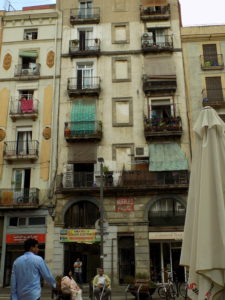I’ve been busy organising the public events for the end of this project as well as writing to start developing my theoretical framework to provide some insights on why a temporal approach to urban change matters. My first article has now been accepted by Space and Culture – the journal. While it will take a while to be published here is a first glimpse of the content:
Urban Regeneration and Resistance: Foregrounding Time and Experience

Carrer Hospital in el Raval
Time and experience lie at the heart of urban life. However while extensive research on the social implications of the spatial transformation of urban landscapes has been undertaken especially since the 1980s, the discussion of the impact manifold temporalities and experiences might have in shaping or constraining the physical and social change of a neighbourhood have been limited. Existing research has a tendency to focus on a specific period in time within the remaking of a neighbourhood and draws conclusions on the impact of the regeneration from this window in time. By drawing on a longitudinal ethnographic study of the regeneration of el Raval, Barcelona from 1996 to now, the aim of this article is to interrogate how a focus on temporality and experience might unsettle common assumptions about contemporary urban regeneration processes and re-frame notions of resistance. While there have been attempts to regenerate this neighbourhood since the early 20th century, most dramatically during the last 20 years to create Barcelona’s new cultural quarter, the neighbourhood has not been gentrified and developed as expected by the council. I argue that while elements of control, discipline and gentrification are certainly part of global contemporary regeneration strategies, temporal and experiential dynamics destabilise their full implementation so that they are only partial in their imposition.
